

(408) Inclusion, Exclusion, Illusion and Collusion : Helen Turnbull at TEDxDelrayBeach. Righting a Wrong - When an Award for Inclusive Education is Not for Inclusion - Starting With Julius. By Catia Malaquias “The language of inclusion is often deployed to shield the practice of exclusion” (Professor Roger Slee).
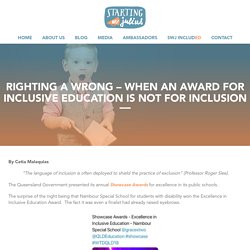
The Queensland Government presented its annual Showcase Awards for excellence in its public schools. The surprise of the night being that Nambour Special School for students with disability won the Excellence in Inclusive Education Award. The fact it was even a finalist had already raised eyebrows. Student Voice: Curtis. Shelley Moore: Transforming Inclusive Education.
Universal Design for Learning (UDL) - Maryland Learning Links. Today’s diverse classrooms are comprised of students with a wide range of abilities, learning preferences and interests.
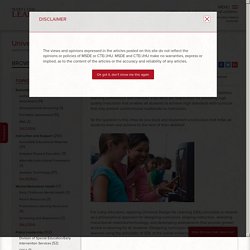
Educators are responsible for providing high quality instruction that enables all students to achieve high standards with curricula that may present unintentional roadblocks to instruction. So the question is this: How do you build and implement a curriculum that helps all students learn and achieve to the best of their abilities? For many educators, applying Universal Design for Learning (UDL) principles is viewed as a philosophical approach for designing curriculum, shaping instruction, selecting instructional materials/technology, and developing assessments that provide greater access to learning for all students.
Designing curriculum and instruction for diverse learners using the principles of UDL at the outset enhances the classroom environment and requires less retrofitting and adaptation by classroom teachers. THE PEOPLE VS THE SCHOOL SYSTEM. From low pass rates to 90 per cent; the Hawke's Bay college nailing Māori education. Adam Ioane reckons he would have dropped out if it wasn't for Flaxmere College's teen parent unit.

Ioane, 17, humble beyond his years, is head boy of the Hawke's Bay school. When he found out he was going to be a father aged just 14, he made plans to quit school and get into full-time work to support the baby. But it wasn't so. Thanks to the unit, his daughter Syphira-Paige, 3, is looked after while he's in class, pitching ahead to plans to study mechatronics at the University of Canterbury next year. READ MORE: * Unconscious bias making Māori students fail * Whānau holding back Māori and Pasifika students * Embracing the spaces which celebrate Māori "She's been my motivation, her and my partner," Ioane says.
"Without the school, I wouldn't be the person I am today. " Flaxmere College, in the heart of the titular Hastings suburb, didn't always cater to students' needs like this. Inclusion vs. Inclusive Practice in Teaching – Novak Educational Consulting. “Inclusion” and “Inclusive Practice” are often used interchangeably in the education world, but there is more to inclusive practice than togetherness.
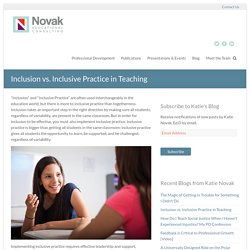
Inclusion takes an important step in the right direction by making sure all students, regardless of variability, are present in the same classroom. Untitled. Inclusive Education Action Group. Who is the Curriculum for?
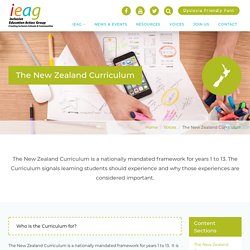
The New Zealand Curriculum is a nationally mandated framework for years 1 to 13. It is for all students and all English medium state schools. The Curriculum signals learning students should experience and why those experiences are considered important. The first half of the Curriculum contains future -focused education outcomes and begins with the vision of “young people who are competent and creative, connected and actively involved” (Ministry of Education, 2007, p. 10). Inclusive Education Action Group. IEAG has produced a short film of each 10 young people talking about how school was for them.
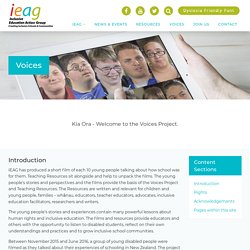
Teaching Resources sit alongside and help to unpack the films. The young people’s stories and perspectives and the films provide the basis of the Voices Project and Teaching Resources. The Resources are written and relevant for children and young people, families – whānau, educators, teacher educators, advocates, inclusive education facilitators, researchers and writers. The young people’s stories and experiences contain many powerful lessons about human rights and inclusive education. The films and resources provide educators and others with the opportunity to listen to disabled students, reflect on their own understandings and practices and to grow inclusive school communities. MOE UDL guide summary. Parents of Disabled Children - Their "Today" Super power baby project. "Don't Cry Wolf!" or 9 Things You Should Never Say to a Panicking Child or Teen.
Whatever you do, don’t cry wolf.
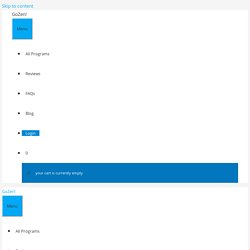
If you do, a huge, bloodthirsty beast with pointy teeth and yellow eyes will come and gobble you up. Do NOT cry wolf. Do NOT ask for help unless you really need it. Ever. Learn about our latest animated series for kids and teens to overcome panic – here! That nightmare-worthy story totally freaked me out as a child.
You’ve probably used the phrase yourself in parenting. Once, in 3rd grade, after I’d finally recovered from an agonizing attack and was lying, panting on the floor in my school nurse’s office, I remember a confused and worried teacher saying to me “Don’t cry wolf, Chloe. Now that I’m older and, luckily, hardly ever get panic attacks I’ve finally realized something important – that story is the baddie, not me. It’s hard to understand panic attacks when you’ve never had one. 1. Aka “That wolf has just bitten off your leg, but just walk on it, OK?”
Would you say “just walk on it!” Try: “I can see you’re scared. 2. 3. 4. Try: “I’m here for you.” 5. Policy statement booklet.